Antenna Integration for Millimeter-Wave RF Sensing and Millimeter-Wave Communication Mountable on a Platform
Abstract
:1. Introduction
2. Design of the Antenna for RF Sensing and That for Communication
3. Integrating the Antennas for RF Sensing and Communication and Experiments
4. Conclusions
Author Contributions
Funding
Institutional Review Board Statement
Informed Consent Statement
Data Availability Statement
Acknowledgments
Conflicts of Interest
Appendix A

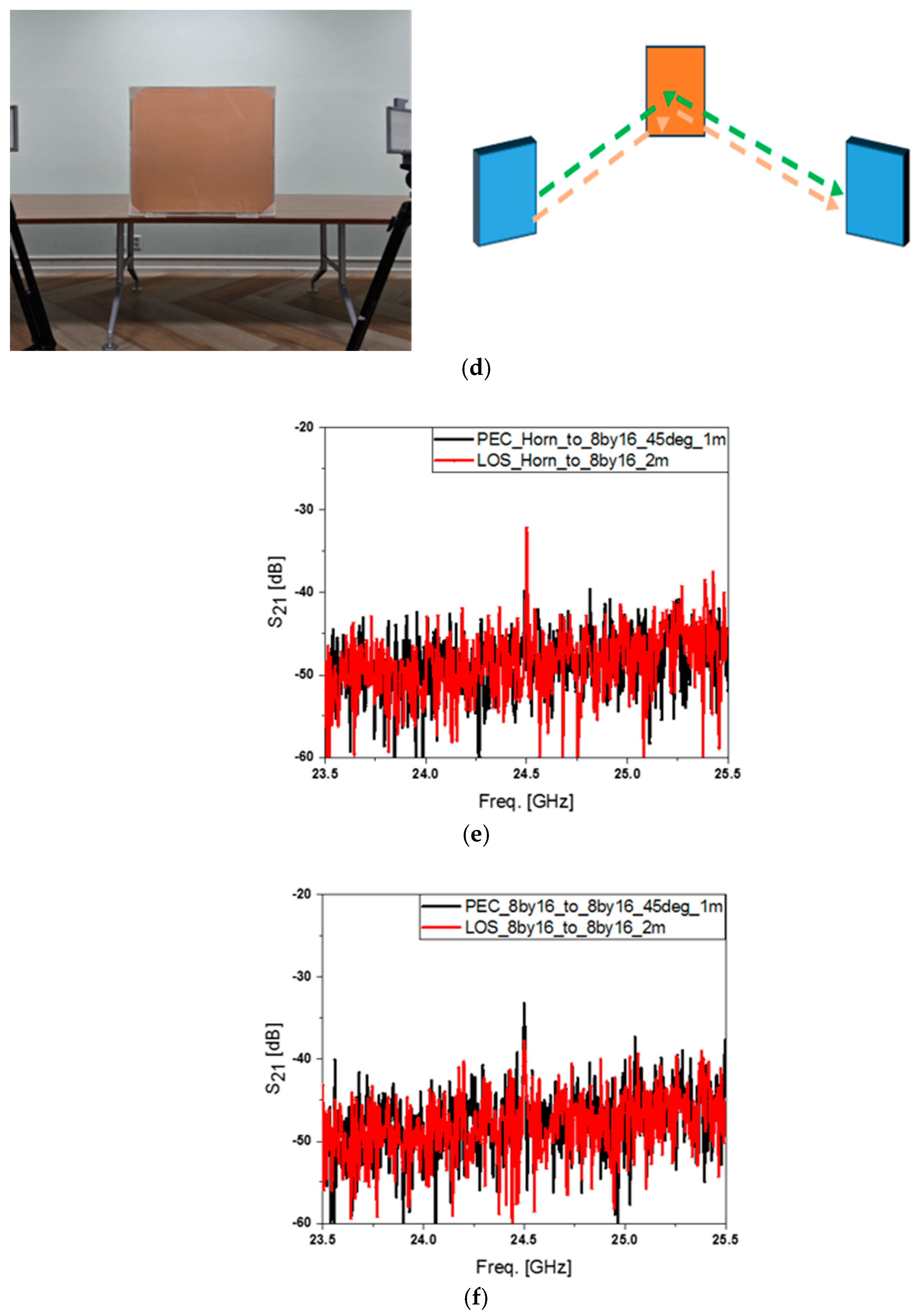

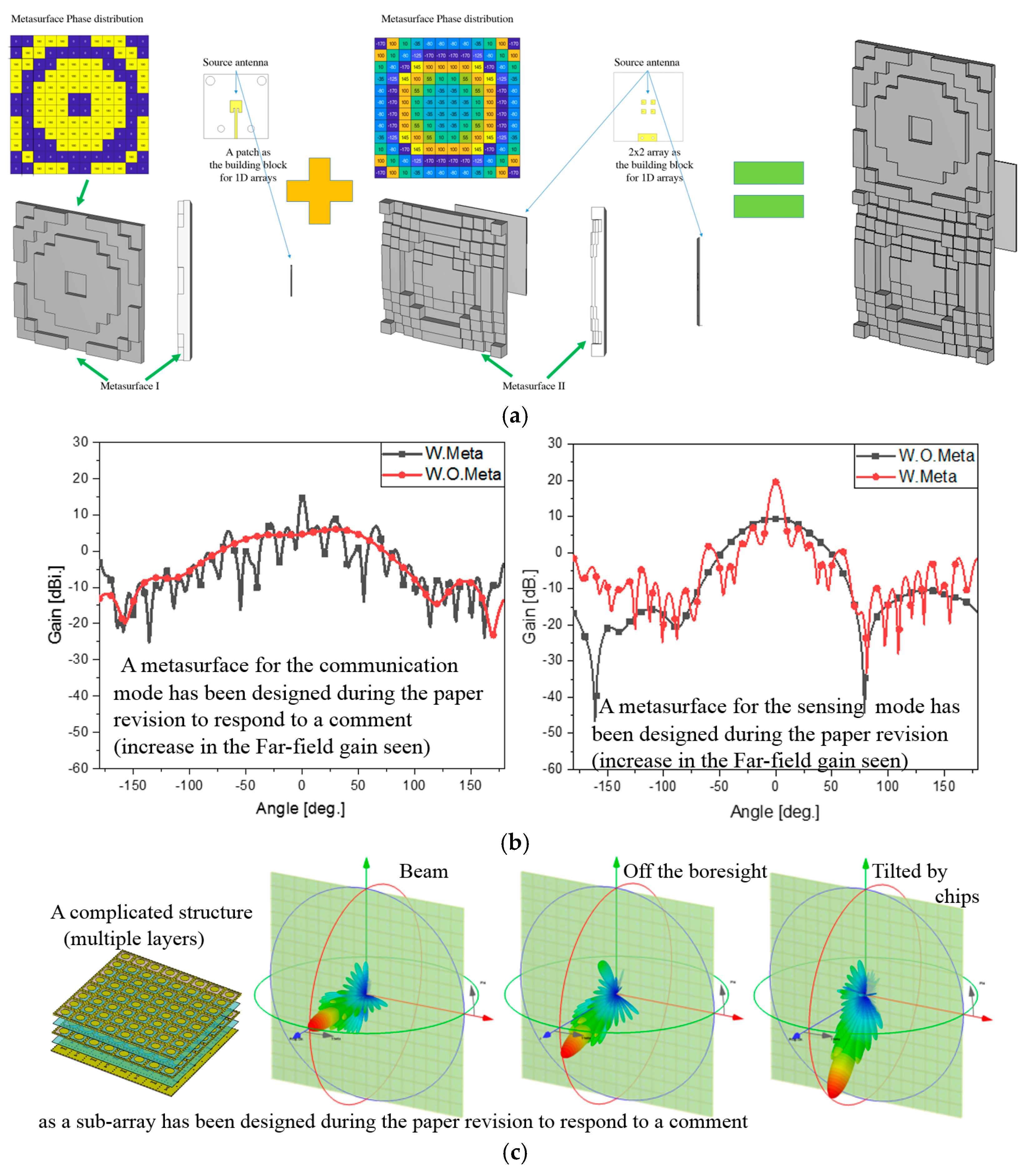

References
- Fu, Y.; Shan, Y.; Zhu, Q.; Hung, K.; Wu, Y.; Quek, T.Q.S. A Distributed Microservice-aware Paradigm for 6G: Challenges, Principles, and Research Opportunities. IEEE Netw. 2023; in press. [Google Scholar] [CrossRef]
- Dong, Y.; Wang, H.; Yang, Z.; Hao, N.; Zhang, C.; Yu, X. Cell-free ISAC massive MIMO systems with capacity-constrained fronthaul links. Digit. Signal Process. 2024, 145, 104341. [Google Scholar] [CrossRef]
- Gao, Z. Integrated Sensing and Communication With mmWave Massive MIMO: A Compressed Sampling Perspective. IEEE Trans. Wirel. Commun. 2023, 22, 1745–1762. [Google Scholar] [CrossRef]
- Islam, M.A.; Alexandropoulos, G.C.; Smida, B. Integrated Sensing and Communication with Millimeter Wave Full Duplex Hybrid Beamforming. In Proceedings of the ICC 2022—IEEE International Conference on Communications, Seoul, Republic of Korea, 16–20 May 2022; pp. 4673–4678. [Google Scholar] [CrossRef]
- Wang, J.; Ma, L.; Wei, Z.; Yang, H.; Pan, C.; Wang, Y. Multi-beam-based Downlink Modeling and Power Allocation Scheme for Integrated Sensing and Communication towards 6G. In Proceedings of the 2022 IEEE 95th Vehicular Technology Conference: (VTC2022-Spring), Helsinki, Finland, 19–22 June 2022; pp. 1–5. [Google Scholar] [CrossRef]
- Zhuo, Y.; Wang, Z. Performance Analysis of ISAC System Under Correlated Communication-Sensing Channel. IEEE Trans. Veh. Technol. 2023, 72, 16823–16827. [Google Scholar] [CrossRef]
- Joung, J.; Yu, H.; Quek, T.Q.S. Integrated single target sensing and multiuser communications based on zero-forcing beamforming. Veh. Commun. 2023, 43, 100637. [Google Scholar] [CrossRef]
- Zhang, R.; Shim, B.; Yuan, W.; Renzo, M.D.; Dang, X.; Wu, W. Integrated Sensing and Communication Waveform Design With Sparse Vector Coding: Low Sidelobes and Ultra Reliability. IEEE Trans. Veh. Technol. 2022, 71, 4489–4494. [Google Scholar] [CrossRef]
- Lu, J.; Ma, L.; Gu, C.; Mao, J. A High-Isolation Duplexer With Mismatched Load Impedance for Integrated Sensing and Communication. IEEE Microw. Wirel. Compon. Lett. 2022, 32, 1127–1130. [Google Scholar] [CrossRef]
- Kraus, J.D.; Marhefka, R. Antennas for All Applications; McGraw-Hill Science: New York, NY, USA, 2001. [Google Scholar]
- Temiz, M.; Peters, N.J.; Horne, C.; Ritchie, M.A.; Masouros, C. Radar-Centric ISAC Through Index Modulation: Over-the-air Experimentation and Trade-offs. In Proceedings of the 2023 IEEE Radar Conference (RadarConf23), San Antonio, TX, USA, 1–4 May 2023; pp. 1–6. [Google Scholar] [CrossRef]
- Huang, K.; Zhang, L.; Li, R.; Tian, Y.; He, Y.; Jiang, J.; Deng, X.; Su, W. A Compact Hybrid G-band Heterodyne Receiver Integrated with Millimeter Microwave Integrated Circuits and Schottky Diode-Based Circuits. Electronics 2023, 12, 2806. [Google Scholar] [CrossRef]
- Liu, D.; Pfeiffer, U.; Grzyb, J.; Gaucher, B. Advanced Millimeter-wave Technologies: Antennas, Packaging and Circuits; Wiley: Hoboken, NJ, USA, 2009. [Google Scholar]
- Jang, J.; Seo, Y.; Lee, Y.; Cho, J.; Kahng, S. A High Gain Reflectarray Antenna for Airborne mmWave Sensing Devices. Microw. J. 2023, 66, 1–28. [Google Scholar]
- Rennings, A.; Otto, S.; Mosig, J.; Caloz, C.; Wolf, I. Extended composite right/left-handed (E-CRLH) metamaterial and its application as quadband quarter-wavelength transmission line. In Proceedings of the 2006 Asia-Pacific Microwave Conference, Yokohama, Japan, 12–15 December 2006. [Google Scholar]
- Jang, G.; Kahng, S. Compact metamaterial zeroth-order resonator bandpass filter for a UHF band and its stopband improvement by transmission zeros. IET Microw. Antennas Propag. 2011, 5, 1175–1181. [Google Scholar] [CrossRef]
- Seo, Y.; Lee, C.; Moon, I.; Ota, K.; Omote, R.; Kahng, S. A Planar Millimeter-Wave Resonator-Array to Sense the Permittivity of COP Film with the 5G Handset Back-Cover. Sensors 2021, 21, 4316. [Google Scholar] [CrossRef] [PubMed]
- Ataloglou, V.G.; Egorov, G.; Kim, J.; Xu, G.; Dorrah, A.H.; Ohadi, A.; Kim, M.; Eleftheriades, G.V. Static and Reconfigurable Huygens’ Metasurfaces. IEEE Antennas Propag. Mag. 2022, 64, 73–84. [Google Scholar] [CrossRef]
- Szymanski, L.; Gok, G.; Grbic, A. Antenna Beamforming With Multiple-Input, Multiplr-Output Metastructures. IEEE Antennas Propag. Mag. 2022, 64, 63–72. [Google Scholar] [CrossRef]
- Alibakhshikenari, M.; Virdee, B.S.; Azpilicueta, L.; Moghadasi, M.N.; See, C.H.; Liu, B.; R. Alhameed, A.A.; Falcone, F.; Huynen, I.; Denidni, T.A.; et al. A Comprehensive Survey of "Metamaterial Transmission-Line Based Antennas: Design, Challenges, and Applications. IEEE Access 2020, 8, 144778–144808. [Google Scholar] [CrossRef]
- Xiao, R.; Ming-Chun, T.; Yu, S.; Zhuo-Fu, D.; Mei, L.; Wei, X. Dual-Polarized, Dual-Band, and Aperture-Shared Synthesis Method for Phased Array Applications. IEEE Trans. Antennas Propag. 2022, 6, 4896–4901. [Google Scholar] [CrossRef]
- Wei, N.; Baohua, S.; Gaonan, Z.; Zhepeng, L. Dual-Band Aperture Shared Antenna Array With Decreased Radiation Pattern Distortion. IEEE Trans. Antennas Propag. 2022, 7, 6048–6053. [Google Scholar]
- Ju, Y.; Gao, Z.; Wang, H.; Liu, L.; Pei, Q.; Dong, M.; Mumtaz, S.; Leung, V. Energy-Efficient Cooperative Secure Communications in mmWave Vehicular Networks Using Deep Recurrent Reinforcement Learning. IEEE Trans. Intell. Transp. Syst. 2024, 5, 1–16. [Google Scholar] [CrossRef]


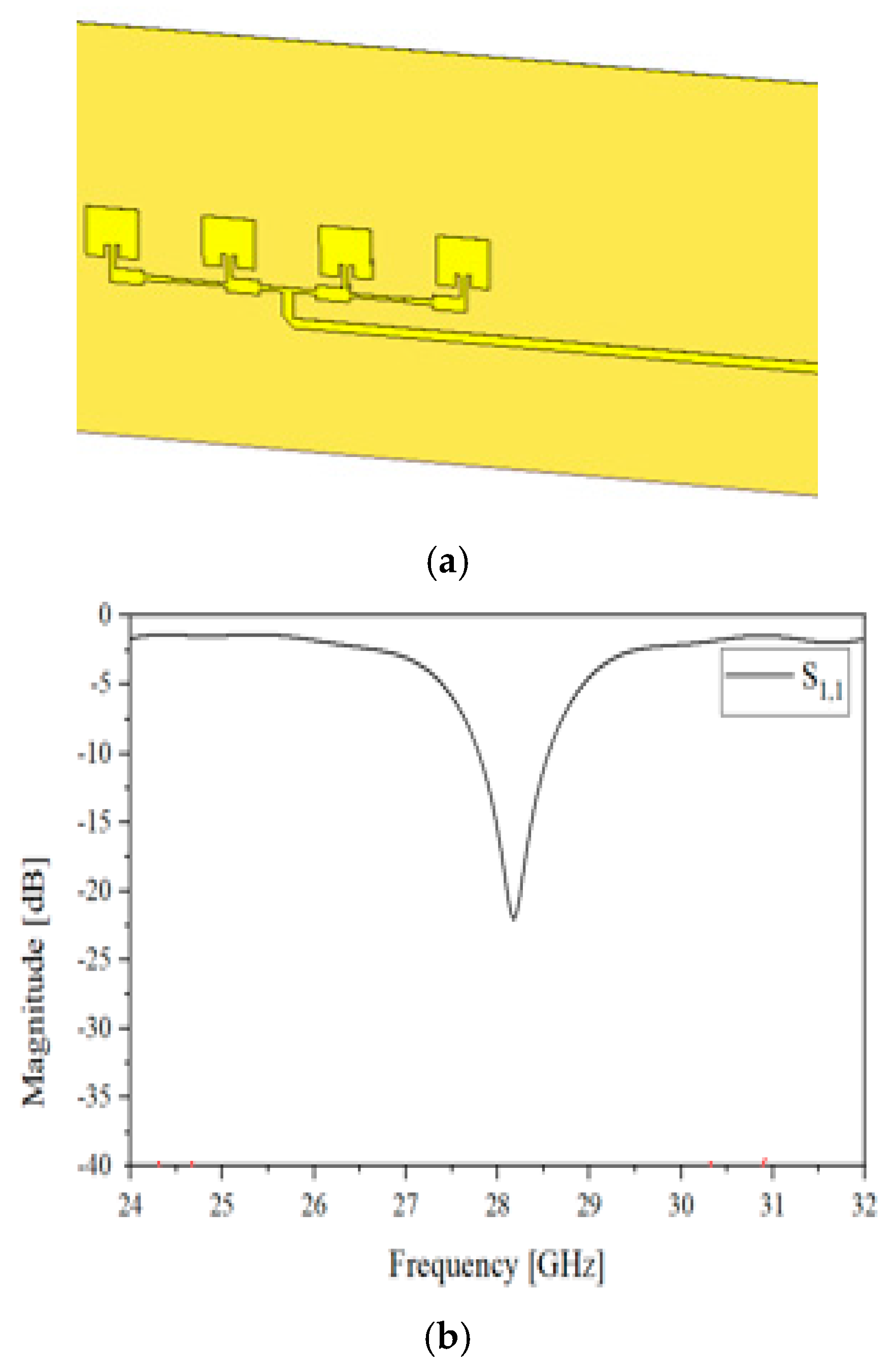


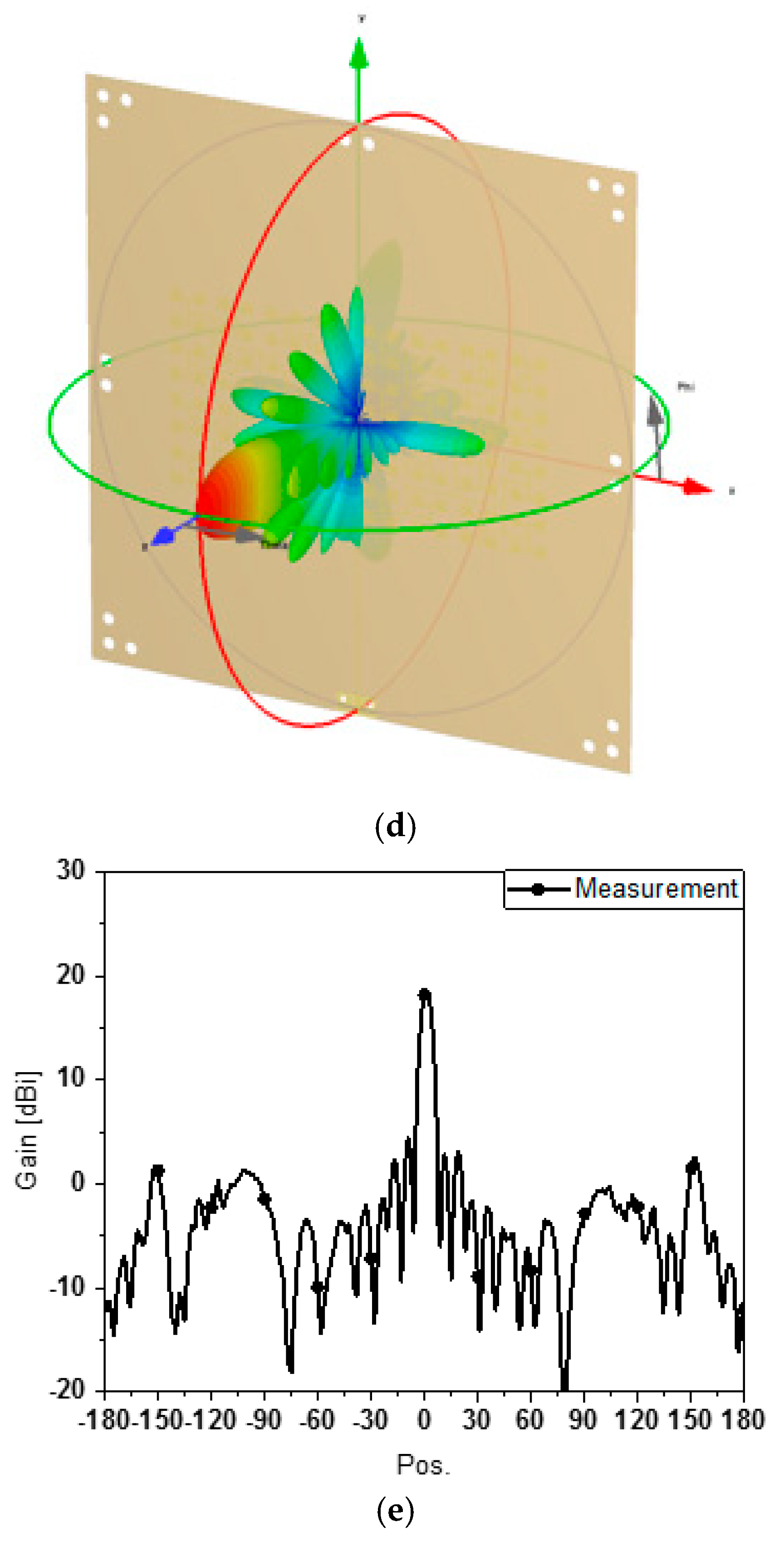



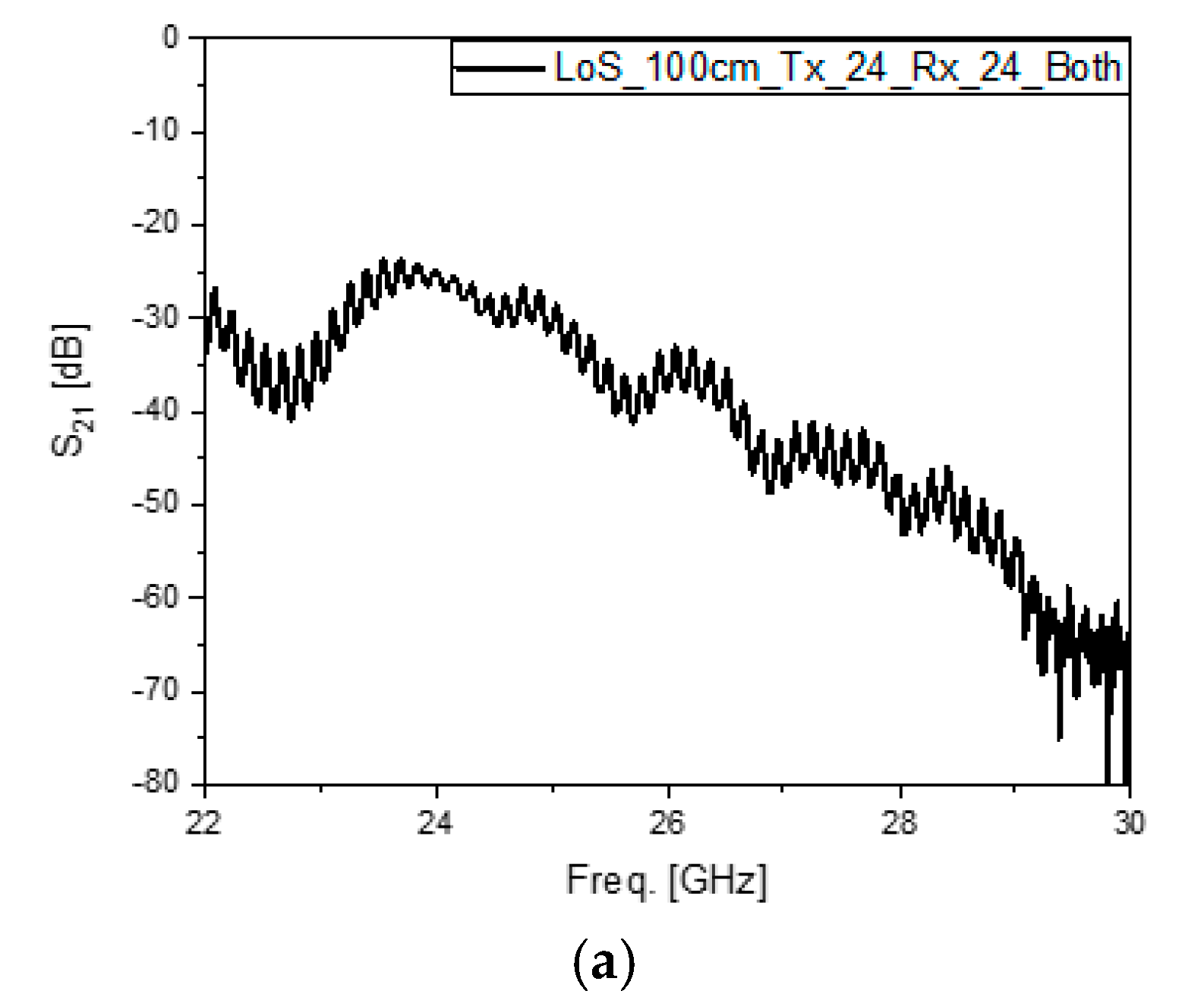


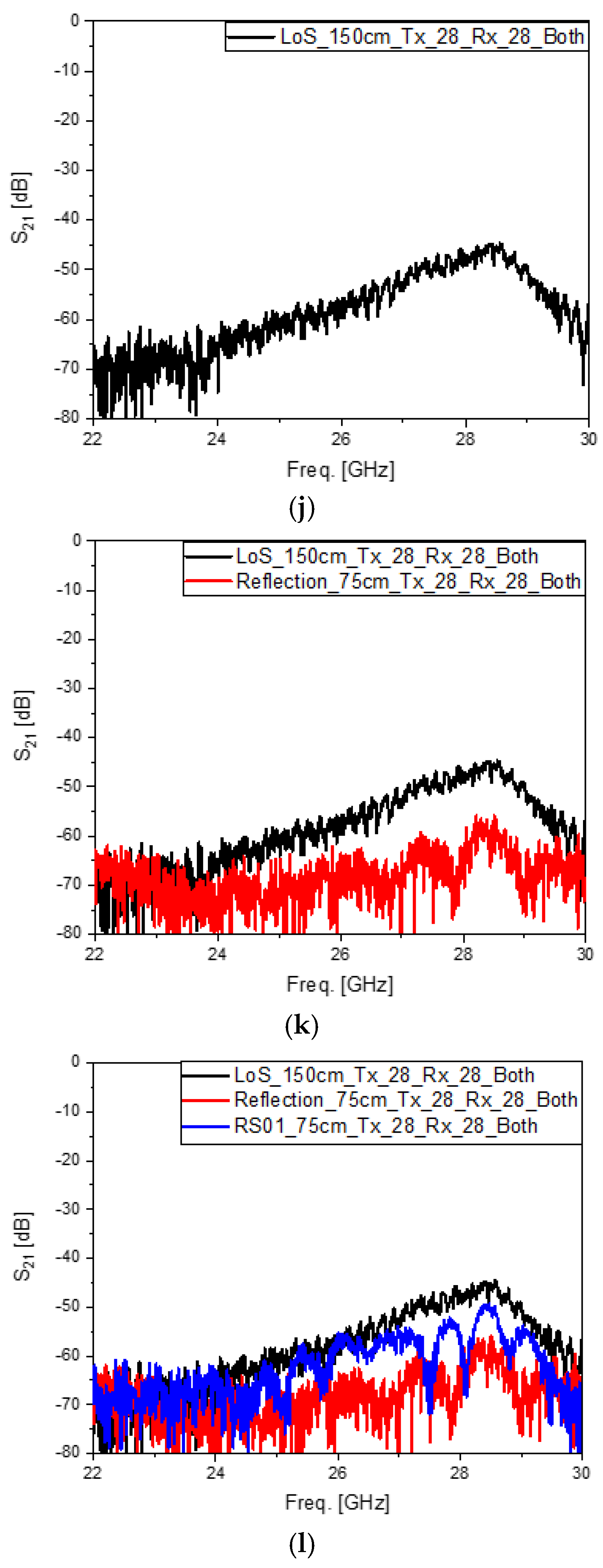
Disclaimer/Publisher’s Note: The statements, opinions and data contained in all publications are solely those of the individual author(s) and contributor(s) and not of MDPI and/or the editor(s). MDPI and/or the editor(s) disclaim responsibility for any injury to people or property resulting from any ideas, methods, instructions or products referred to in the content. |
© 2024 by the authors. Licensee MDPI, Basel, Switzerland. This article is an open access article distributed under the terms and conditions of the Creative Commons Attribution (CC BY) license (https://creativecommons.org/licenses/by/4.0/).
Share and Cite
Koh, J.; Park, H.; Kim, W.; Seo, S.; Seo, Y.; Kahng, S. Antenna Integration for Millimeter-Wave RF Sensing and Millimeter-Wave Communication Mountable on a Platform. Sensors 2024, 24, 4838. https://doi.org/10.3390/s24154838
Koh J, Park H, Kim W, Seo S, Seo Y, Kahng S. Antenna Integration for Millimeter-Wave RF Sensing and Millimeter-Wave Communication Mountable on a Platform. Sensors. 2024; 24(15):4838. https://doi.org/10.3390/s24154838
Chicago/Turabian StyleKoh, Jaewon, Hongsik Park, Woogon Kim, Seongbu Seo, Yejune Seo, and Sungtek Kahng. 2024. "Antenna Integration for Millimeter-Wave RF Sensing and Millimeter-Wave Communication Mountable on a Platform" Sensors 24, no. 15: 4838. https://doi.org/10.3390/s24154838



